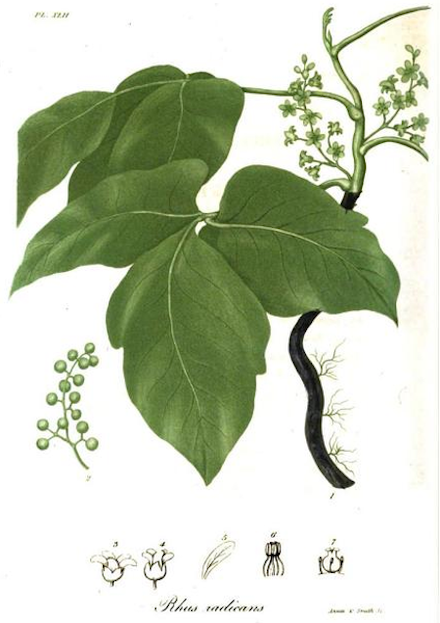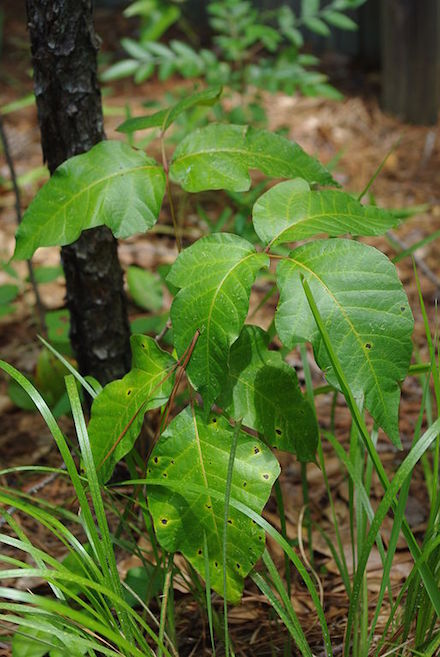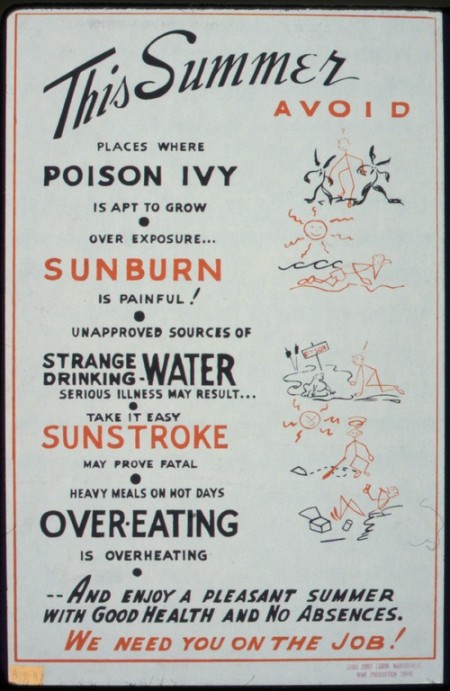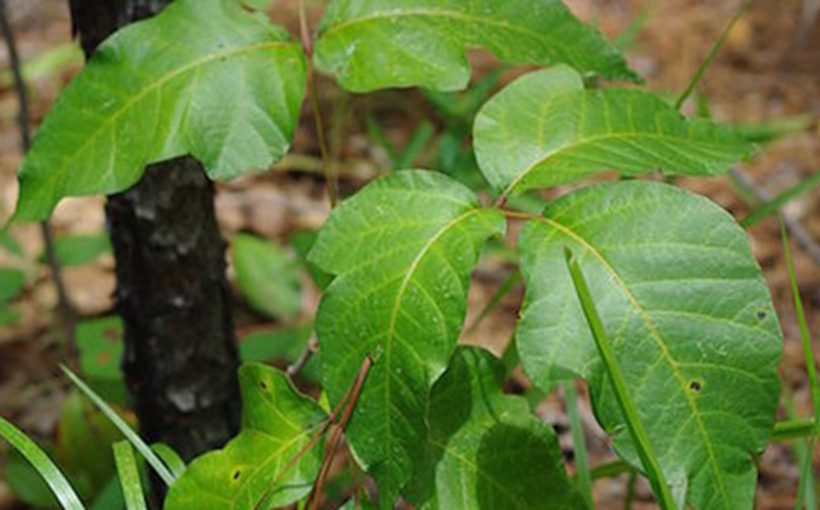While poison ivy is an occupational hazard for gardeners, we’ve found some ways to minimize it. Read on for tips from the pros!
How do you identify poison ivy?
The trick to identifying Toxicodendron radicans is to look for three oval, slightly pointed leaves that emerge from one petiole (the stem that links the leaf and the main stem), ANDwhose leaves have an alternate arrangement. An alternate leaf arrangement means that one petiole emerges from the stem on one side of the plant, the next petiole farther up on the opposite side, and so forth. You can see it in this botanical illustration of poison ivy.

If, on the other hand, your leaves-of-three plant has leaves that emerge from the same point on two sides of the stem, you have a plant with opposite leaf arrangement, and you’re not dealing with PI.
Why does it make you itch?
Poison ivy, like poison oak and poison sumac, has an oil called urushiol. If this oil contacts the skin and bonds with it, most people will develop a rash in 24 to 36 hours.
You have a 10-to-15 minute window before the oil bonds to your skin. If you think you’ve made contact with PI, immediately wash with cold water and an alkali soap like naptha or Tecnu.
Where do you find poison ivy?
Everywhere. Seriously, PI can creep along the ground, take the form of a small shrub, or vine up buildings and trees.
But you’ll most often find PI in areas that are disturbed. Clearings that were cut and then not maintained, roadsides, even gardens where the soil is repeated churned up are all likely spots.

PI can have a touch of red on the stems, and it usually turns brilliant orange in the fall. Photo by Bmerva, used under CCA-SA 3.0.
And PI is a champ at blending in with other vines, like English ivy, Virginia creeper, and euonymus.
How do you get rid of it?
It’s almost impossible to really get rid of PI. Even a small bit of root will resprout. We’ve heard the best way to eradicate PI is getting a goat to graze on it, but that’s not super practical for the urban gardener.
This article from University of Missouri Extension Service recommends herbicides that are supposed to control PI. However, you must apply the herbicides repeatedly and consistently over the long term.
Instead of getting rid of poison ivy, your goal is to manage it. Pull it when you see it, avoid churning up the ground around it, and try to keep it from spreading.
Never use a string trimmer on PI (you can splatter the urishol all over your legs and create a hideous rash). And absolutely never burn it. The urushiol can get into the lungs that way. Throw PI in the trash, not the compost.

This WWII sign offers great advice, but sometimes we just CAN’T avoid the poison ivy!
How the Spotts Team Deals with Poison Ivy
We prefer mechanical controls: cutting plants to the ground every time we see them, or digging out small plants. If PI is growing up a tree, we’ll cut the stems off at the bottom and leave the PI to die.
We wear long pants and sleeves, as well as long socks when working near PI. We also use Ivy X Pre-Contact as a block. Apply it like sunscreen before exposure.
For small infestations of poison ivy, we put a plastic bag on over our gloved hand, rip the PI out by the roots, and turn the bag inside out as we take it off our hands. We then immediately wipe gloves and any tools with a disinfectant wipe.
After exposure to PI, we swab down with Ivy X Post-Contact or Technu as soon as possible. Both of these outdoor skin cleansers can be used even if you don’t have access to water. If we’re in PI all day, we’ll swab down with one of these post-contact treatments every few hours and before we eat or use the restroom. Then we’ll apply more Ivy-X Pre-Contact before wading back in.
Poison Ivy (Not-So) Fun Facts
- The urushiol oil can be transmitted by pets, tools, and clothing.
- Urushiol stays active on surfaces, including dead plant surfaces, for up to 5 years.
- The rash from PI often starts out looking like a lash mark: a straight line on the skin.
- Even those who do not have a reaction to urushiol can develop it at any time; just because you’re immune now doesn’t mean you’ll always be.
- Poison ivy rash does not spread, at least not after the oil bonds with the skin. Within that 15-minute window, the oils can get moved around, causing rashes in strange places.
- Rash develops most quickly where you get the most oil; rashes that show up later are in spots that got less oil.
